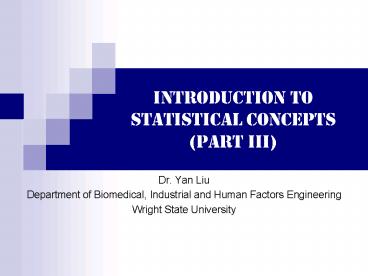Introduction to statistical concepts Part III - PowerPoint PPT Presentation
1 / 17
Title:
Introduction to statistical concepts Part III
Description:
... curve, symmetric about X = . Shape of the ... What is the probability that such a tube will last at least 1,250 hours? ... 0.287. X = life in hours of the tube ... – PowerPoint PPT presentation
Number of Views:33
Avg rating:3.0/5.0
Title: Introduction to statistical concepts Part III
1
Introduction to statistical concepts(Part III)
- Dr. Yan Liu
- Department of Biomedical, Industrial and Human
Factors Engineering - Wright State University
2
Normal Distribution
- The normal distribution (also known as Gaussian
distribution) with parameters µ and s, N(µ,s), is
the continuous probability distribution with the
following probability density function - Normal distribution is the cornerstone of the
field of statistical inference - Many distributions can be well approximated by
the normal distribution - e.g. weight, height, bolt diameter, resistance
of wire, construction error, etc.
(Eq. 1)
Where p 3.14159, e 2.71828
3
Normal Distribution
- A bell curve, symmetric about X µ
- Shape of the curve is determined by s
- the larger s is, the flatter the curve is
s2 gt s1
Graph of the Probability Dense Function of Normal
Distribution
4
Standard Normal Distribution
- The standard normal distribution is the normal
distribution with parameters µ0 and s1, N(0,1),
and has the following probability density
function - For ZN(0,1), P(Zltz) is equal to the area of the
region to the left of the ordinate Z z that is
bounded by the graph of its density function and
the horizontal axis - Why N(0,1)?
- We can use the table of standard normal
distribution to calculate probabilities (can be
downloaded from the course website)
(Eq. 2)
5
What is the total area under curve?
6
P(Zlt-z) P(Zgtz), for zgt0
7
Z Score
- The z score of a random variable X N(µ,s) is
computed as
(Eq. 3)
X N(µ20, s2), P(X gt23)?
ZX (X-20)/2
P(X gt23) P(ZX gt (23-20)/2) P(ZX gt1.5) 1-
P(ZX lt 1.5) 1- 0.9332
0.0668 0.07
8
Suppose the resistance of a carbon composition
resistor is normally distributed with mean µ
1,000 and variance s2 900. What is the
probability that the resistor has measurement in
excess of 1,060 ohms?
Define X
X the resistance of a carbon composition
X N(µ1000, s30), P(X gt1060)?
ZX (X-1000)/30
P(X gt1060) P(ZX gt (1060-1000)/30) P(ZX gt2)
1- P(ZX lt 2) 1- 0.9772
0.0228 0.02
9
Students t-Distribution
- Students t-distribution or t-distribution is
used to replace normal distribution when the
standard deviation s is not known and thus has to
be estimated using sample standard deviation s
10
Students t-Distribution
- Suppose a random sample of size n is drawn from a
normal distribution with mean µ and standard
deviation s (unknown), then
(Eq. 4)
11
Confidence Interval
- A confidence interval gives an estimated range of
values which is likely to include an unknown
population parameter it is calculated from a
given set of sample data - Confidence Level
- How sure the confidence interval includes the
true value of the population parameter to be
estimated
We are 95 confident that between 60 and 70
people will agree with this proposal.
95 is our confidence level (60, 70) is our
confidence interval
12
Confidence Interval for Mean
- Suppose a random sample of size n is drawn from a
normal distribution with mean µ and standard
deviation s (unknown), then the confidence
interval for µ is
(Eq. 6)
where a is significance level and equal to (1
confidence level)
- t-distribution table can be downloaded from the
course website
13
(No Transcript)
14
Suppose these grades are sampled from a normal
distribution with mean µ and standard deviation s
(unknown), find the confidence interval of the
mean of the grades with 95 confidence level
a 0.05, n10
ta/2 (10-1) ta/2 (9) 2.262
The confidence interval for µ is (86.2-2.2625.75
/v10, 86.22.2625.75/v10) (82.09, 91.31)
X grades of student
15
Exponential Distribution
- Often used to model the time interval between
independent events that happen at a constant
average rate - The probability density function of an
exponential function has the form
(Eq. 7)
? gt 0 is a parameter of the distribution, often
called the rate parameter
- The cumulative distribution is given by
(Eq. 8)
- Mean and Variance
(Eq. 10)
(Eq. 9)
var(X) 1/?2
E(X) 1/?
16
fX(x)
X
Probability Dense Function of Exponential
Distribution
17
Suppose the life in hours of a certain type of
tube is a random variable that has an exponential
distribution with a mean of 1,000 hours. What is
its probability density function? What is the
probability that such a tube will last at least
1,250 hours?
X life in hours of the tube
E(X) 1000 1/? ? ? 1/1000
f(x) 1/1000 e(-1/1000)x
P(X 1250) 1- P(X lt1250) 1- F(X1250) 1- (1-
e(-1/1000)1250 ) e(-1/1000)1250
0.287































